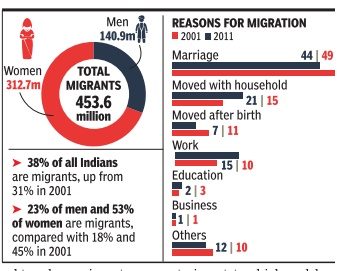Migration: India
This is a collection of articles archived for the excellence of their content. |
Contents |
Internal migration
40% Indians migrants; mainly for marriage
Subodh Varma, 4 of 10 Indians migrants, most move for marriage, Dec 2, 2016: The Times of India


Nearly two out of five Indians -some 454 mil lion in all -are migrants, having left their place of residence and settled down somewhere else, according to fresh Census 2011 data on migration released on Thursday . Between 2001 and 2011, 139 million Indians migrated within the country . The vast majority of migrants, 69%, are women moving out of their parental homes to stay with their husbands in their native homes, or perhaps migrate with them elsewhere.
Half of this massive movement of humanity is taking place within rural areas -rural-to-rural migration.Rural-to-urban migration makes up about 18% while urban-to-urban is another 17%. In 2001, the share of ru ral-to-urban migrants was about 17%, indicating that there has not been a big shift in the percentage of people moving from villages to cities during the 2001-2011decade over the 1991-2001decade.
This complements the earlier data given by the census that the urban growth ra te is not too high and has slackened in many cities.
Among the reasons cited for migration by those surveyed, about 10% moved in search of employment during the decade ending 2011, down from 15% in 2001. This is counterintuiti ve, considering the po pular belief that mig ration is primarily driven by work.The share of those moving to pursue education makes up only 2% of migrants, down from 3% recorded in the 2001 census.
Marria ge remains the biggest cause for migration, accounting for 49%, up from 44% in 2001. The census questionnaire includes a reason de signated as “moved after birth“, which is mainly children being born in a pla ce -the mothers' village or a nearby town with hospital -and then moving back home to the parental ho use. This share has in 7% creased from in 2001 to 11%More in 2011.
than a fifth of all migrants had said in 2001 that the reason for migrating was that their fa mily was moving. They wo uld be dependents, both yo ung and old. This share has declined to 15% in 2011.
Women migrating abroad
2010
Changing times: More women go abroad to work
Divya A |
June 2010
Deepa Gupta, 22, a mathematics graduate from Ludhiana, thought it a great opportunity to go to a postgraduate course in Michigan University. Two years down the line, she is settled in the US and has been joined by her widowed mother.
Gupta represents a trend — that of Indian women increasingly leaving home turf for professional, rather than personal reasons. The World Bank’s report on ‘Gender, Poverty Reduction and Migration’ says more women from developing countries such as India are migrating to the West independently rather than as dependents. It also says that female migration indirectly helps alleviate poverty.
Neelam Soni, executive with an overseas placement agency in Delhi says women in nursing, teaching, social and voluntary work, the hospitality industry, data-entry operations, sales and even housework are able to migrate to foreign shores.
Social scientist Mala Kapur Shankardass says that even though a large proportion of female migration can still be explained away by marriage (estimates say 80%) it is significant that 20% of all women migrants leave for professional reasons. A decade ago, less than 5% of women migrants worked She says that earlier, male migrants used to belong to the ‘Employed’ category and female to the ‘Not in the Labour Force’. This is changing. Shankardass.
But Shankardass cautions that Indian female contribution to forex remittances is still not properly documented. Official data largely focuses on male remittances.
See also
Migration: India